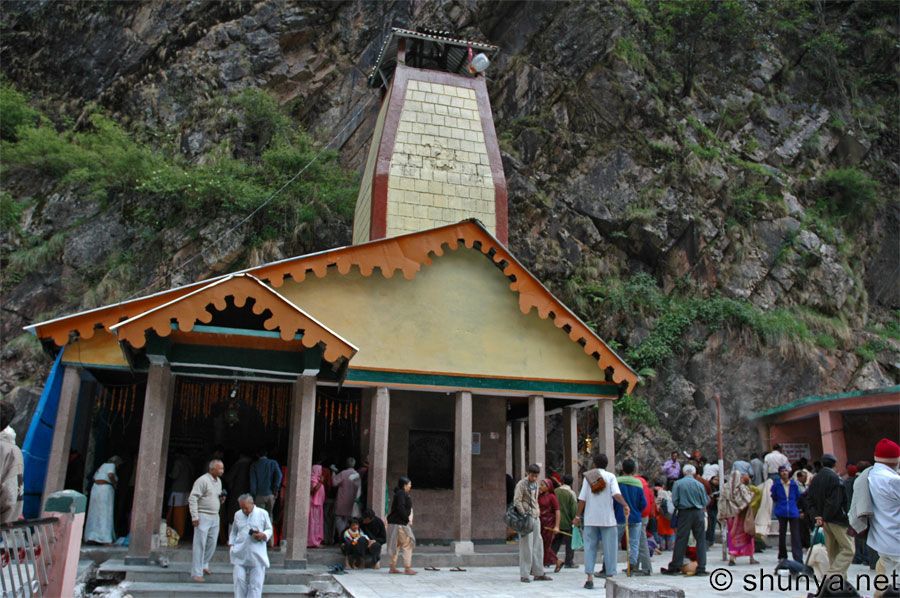The first stopover for the Char Dham Yatra is the westernmost shrine of Yamunotri in the Garhwal Himalayas. Dedicated to Goddess yamuna, it is perched atop a flank of the Bandar Poonchh peak (3.165 mts. Above sea level) and is situated opposite to Gangotri. The shrine attracts devotees in large numbers from May to October.Yamunotri is the source of the revered river yamuna which originates from the Champasar Glacier lying 1 km ahead of the shrine, at an altitude of 4,321 mts. Pilgrims do not frequently visit the source of the river as it is not easily accessible.
View Larger Map
Yamunotri - From Wikipedia
Yamunotri (Hindi: यमुनोत्री) is the source of
the Yamuna River and the seat of the Goddess Yamuna inHinduism. It is situated
at an altitude of 3,293 metres (10,804 ft) in the Garhwal Himalayas and located approximately 30 kilometers (19 mi) North of Uttarkashi, the headquarters
of the Uttarkashi
district in the Garhwal Division of Uttarakhand, India. It is one of the
four sites in India's Chhota Char
Dham pilgrimage. The sacred shrine of Yamunotri, source of the
river Yamuna, is the westernmost shrine in the Garhwal Himalayas, perched atop
a flank of Bandar Poonch Parvat. The chief attraction at Yamunotri is the
temple devoted to the Goddess Yamuna and the holy thermal springs at Janki
Chatti (7 km. Away).
The actual source,
a frozen lake of ice and glacier (Champasar Glacier) located on the Kalind
Mountain at a height of 4,421 m above sea level, about 1 km further up, is
not frequented generally as it is not accessible; hence the shrine has been
located on the foot of the hill. The approach is extremely difficult and
pilgrims therefore offer puja at the temple itself.
The temple of
Yamuna, on the left bank of the Yamuna, was constructed by Maharaja Pratap Shah
of Tehri Garhwal. The deity is made of black marble. The Yamuna, like the
Ganges, has been elavated to the status of a divine mother for the Hindus and
has been held responsible for nurturing and developing the Indian civilization.
Close to the
temple are hot water springs gushing out from the mountain cavities. Surya Kund
is the most important kund. Near the Surya
Kund there is a shila called Divya Shila, which is worshipped before puja is
offered to the deity. Devotees prepare rice and potatoes, tied in muslin cloth,
to offer at the shrine by dipping them in these hot water springs. Rice so
cooked is taken back home as prasadam. The pujarisof Yamunotri come from the village of Kharsali near Janki
Chatti. They are the administrators of the sacred place and perform religious
rites. They are well-versed in the Shastras.
History and
legends
According to the
legend ancient, sage Asit Muni had his hermitage here. All his life, he bathed
daily both in the Ganges and the Yamuna. Unable to go to Gangotri during his
old age, a stream of the Ganges appeared opposite Yamunotri for him.
The temple and the
place opens every year on the auspicious day of the Akshaya Tritya, which
generally falls during the last week of April, or the first week of May. The
temple always closes on the sacred day of Diwali in mid-October - first week of
November, with a brief ceremony. The temple staff return to their villages and
for the rest of the time the valley is gripped in no-man silence and covered
with a white sheet of snow. With the melting of the snow next summer, the
temple re-opens to the blissful happiness of thousands of visitors again.
The daughter of
the Sun god, Surya and consciousness, Sangya the birth place of the Yamuna is
the Champasar Glacier (4,421 m) just below the Banderpoonch Mountain. The
mountain adjacent to the river source is dedicated to her father, and is called
Kalind Parvat, Kalind being another name of Surya. Yamuna is known for her
frivolousness, a trait that she developed because, according to a common story,
Yamuna's mother could never make eye contact with her dazzling husband.
How to reach
Air: The nearest
airport is Jolly Grant.
Rail: The nearest
railhead is at Rishikesh.
Road: The road to
Yamunotri diverts from the Rishikesh-Gangotri road at Dharasu.
Important road
distances : Hanumanchatti 13 km; Dharasu 107 km; Tehri
149 km.
Rishikesh to
Yamunotri 222 km via Narendranagar 16 km, Chamba 46 km,
Brahmkhal 15 km, Barkot 40 km, Sayanachatti 27 km, Hanumanchatti
6 km, Phoolchatti 5 km, Jankichatti 3 km and Yamunotri
6 km.


















0 comments:
Post a Comment